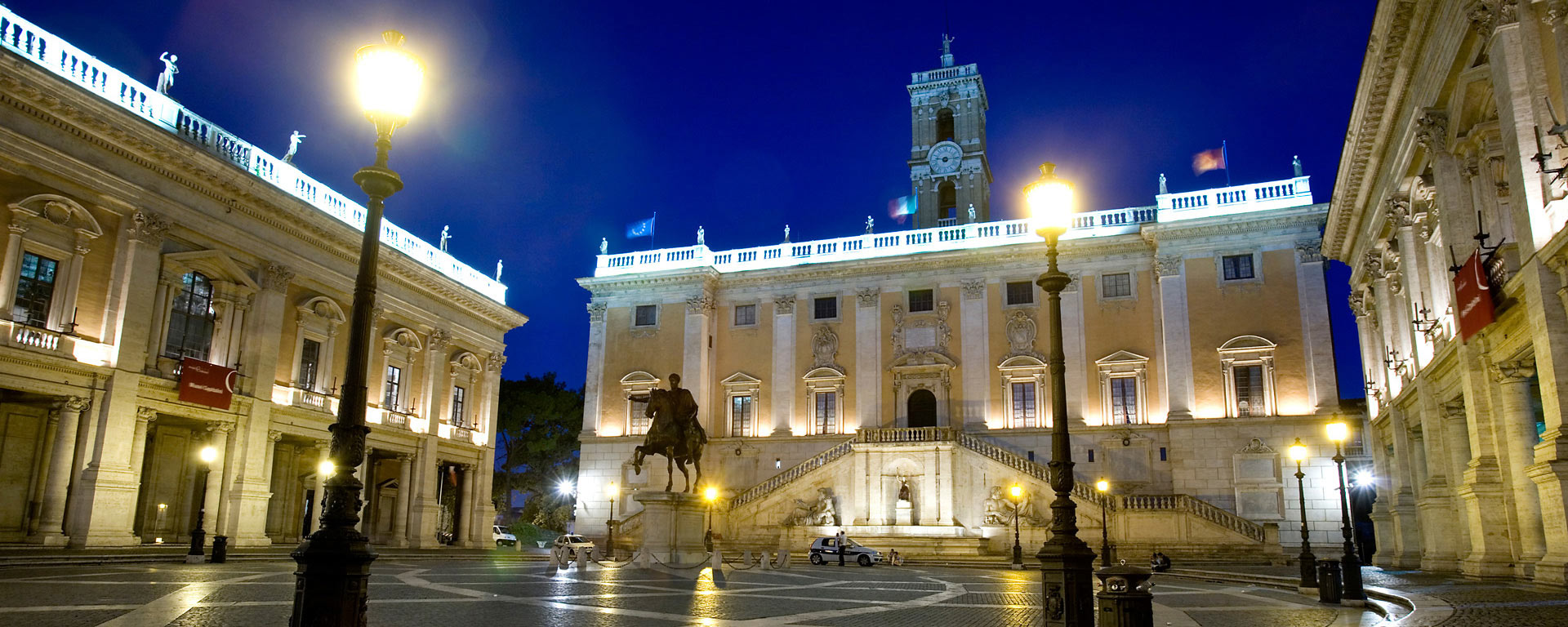
campidoglio – the heart of ancient rome
The Campidoglio, or Capitoline Hill, is the smallest of Rome’s infamous seven hills. It is the location of the Rome’s City Council.
Excavations have uncovered settlements going back to the Bronze Age, 1300 BC, making it more than likely the first place in Rome to be settled.
Its name derives from caput or head in Latin and is like the English word cap for a head or hat.
An actual skull was found in the sixth century BC when the ancient Romans were digging the foundations of the temple which took pride of place on this hill, the Temple of Jupiter Optimus Maximus or Jupiter Capitolinus.
That combined with the Campigodlio’s visual prominence over the Roman Forum is probably responsible for its name.
This temple had statues of the three main Gods of Rome: Jupiter, Juno and Minerva.
They were called the Capitoline Triad. Jupiter was the counterpart of Zeus, father of the Gods, Juno was his wife although he had numerous human lovers and Minerva was their daughter, depending on what source you believe.
capitoline hill
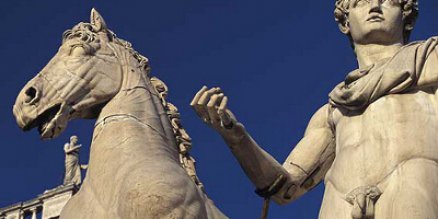
The first temple dated back to 509 BC started by the last kings of Rome, the Tarquins.
Its area was 180 ft x 180 ft (or 60m²) making it the largest temple in the citadel.
Steps reached three rows of six front facing columns which lead to the cella or main room of the building.
The cella was divided in to three rooms with a statue of each god in each room; Juno on the left, Minerva on the right, and Jupiter in the middle.
As well as statues, the temple contained 3 books of prophecy about the future of Rome written by the Sybil, a female prophet, in ancient Greek.
Legend records that she offered Tarquinius Superbus 9 books of these prophecies for a ridiculous amount of money, say a million units of currency.
Tarquin refused, obviously. She then went off and burned three of these books and returned, offering him 6 for the same price.
He again refused, but this time less sure. The Sybil burned another three books and offered them to the king for the same original price.
This time he agreed and they were placed in Rome’s holiest temple.
Anytime something bad happened to Rome, such as the defeat of its armies, a plague or lightning striking a building, the priests of Jupiter consulted the books to help them decide if this was prophesied and to find out what the Gods wanted to make it all stop.
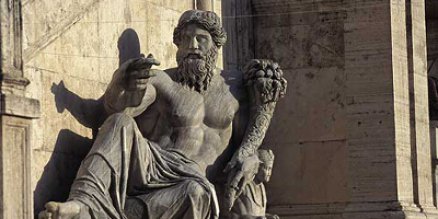 The temple of Jupiter was rebuilt in 83 BC after a fire with the sibylline books going up the blaze too according to some accounts.
The temple of Jupiter was rebuilt in 83 BC after a fire with the sibylline books going up the blaze too according to some accounts.
A new state library was also built at the forum end of the Campidoglio called the Tabularium, or tablet repository as the ancient Roman laws were orginally carved in stone, which still provides the foundations of the city government building which you can see on the top of this square.
Much later in 44 BC, when Brutus and Cassius murdered Caesar in the Theatre of Pompey, beside Campo di Fiori, they walked through Rome with the blood stained dagger and locked themselves in the Temple of Jupiter, a sign of the hill’s prestige and also as the people of Rome were quite annoyed with them; Caesar had been popular.
When the last descendant of Caesar, the crazy Emperor Nero, was killed in 69 AD, it caused a civil war with four claimants to the throne.
The eventual successor, the general Vespasian – who built the Colosseum – had for a time to lock himself in the Temple of Jupiter, which was burned by his opponent Vitellus.
Vespasian eventually got out of course and founded Rome’s second durable dynasty of Emperors and rebuilt the temple.
Another fire in 80 AD claimed this temple and it was finally rebuilt by Domitian – the last of the Flavians – lasting for four hundred years until it was burned down by the Germanic warlord Stilchio.
capitol hill
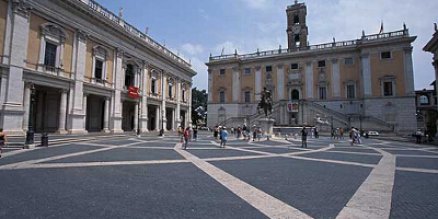
Another smaller temple was also located on the slopes of the Campidoglio dedicated to Jupiter’s wife Juno.
Built in 343 BC, the temple of Juno Moneta became associated with a mint or coin making factory nearby and this is where we get the English word money.
The temple was guarded by geese, which were sacred to the goddess.
These Capitoline geese had resided on the hill prior to the Temple’s construction and apparently alerted the Romans to an invasion of Celts in 390 BC.
Gauls, or Celts of Northern Italy, invaded and sacked Rome, the Romans held out here and fortified the hill.
what is the capital of rome
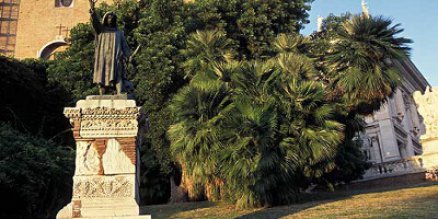
The little statue on the left as you walk up the front stairs of the Campidoglio is Cola di Rienzo or Nicolas di Lorenzo.
He was a fourteenth century politician who took over the City of Rome and tried to unify Italy and restore Rome as the head of a new Roman Republic.
A very popular and interesting character for a time, he brought order to this city and got rid of crime.
He interfered with European politics, was arrested and locked up by the Holy Roman Emperor Charles IV.
Later released by the Pope, he seized power again but his rule was oppressive so he was killed by a mob in 1354 whilst trying to escape his house.
Many people wrote plays about him, admiring his love for the Roman Republic and his unsuccessful attempts to restore it, such as Friedrich Engels, the man who co-authored the Communist Manifesto with Karl Marx, and German composer Richard Wagner wrote an opera about him.
palazzo dei conservatori
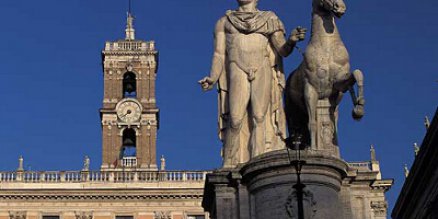
Michelangelo worked on the Capitoline Hill for 10 years from 1536 to 1546 at the same time was he was painting the Last Judgement in the Sistine Chapel.
He worked 16 hours per day and it’s no wonder he never had a chance to marry (he was probably not interested in the opposite sex).
This staircase is called the cordonnata stairway and was intended for the arrival of the Holy Roman (or basically German) Emperor Charles V in 1538.
Prior to this the only approach to the Campidoglio was from the Forum which is now the back way.
Being so busy, Michelangelo didn’t get it finished in time so the Emperor had to go in the back way as all of this area had scaffolding around it.
Its steps are long, flat and slope gently to allow a horse to walk up them. Giacomo Della Porta carried out further work on the steps in 1578.
The two lions at the bottom of the staircase are made of Egyptian black granite and date from the 3rd Century BC.
They were later bored with holes so they could act as fountains and water from the Acqua Vergine supplies their mouths during the summer.
Giuseppe Valadier would later copy them for Piazza del Popolo.
michelangelo architecture
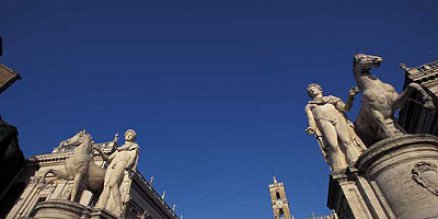
The two statues at the top of the staircase are of Castor and Pollux.
These two guys were demi-Gods, sons of Zeus or Jupiter.
When the ancient Romans kicked out their last king in 509 BC, there was a war where the king tried to take back Rome from the now republican Romans.
According to legend, Castor and Pollux showed up and rallied the Romans to Victory on white horses, later appearing in the Forum behind here and telling the locals they had won.
Due to the fact they were the sons of Jupiter, these statues were put here as the Temple of Jupiter had been on the right.
The statues were found in the Jewish Ghetto where there had been a temple to the twins.
Previously the Capitoline Hill had been orientated on the direction of the Forum.
Michelangelo redesigned it and the stairs to point towards the Vatican and the city which was now located in that direction.
The Popes owned Rome during the Middle Ages and the Forum on the other side had developed in to a trash dump with farmers using it for grazing animals, so it was a good idea.
capitoline museum
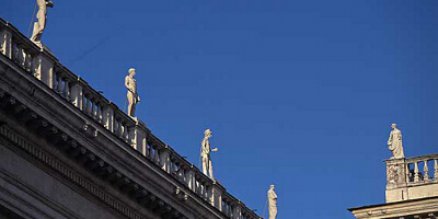 Palaces of the Capitoline
Palaces of the CapitolineThe building in the middle of the square is the Palazzo Senatorio, or Senatorial Palace.
This was the earliest of the three palazzi, built in the 12th century by the Corsi noble family over the remains of the Tabularium or Tablet Office of the Senate Records (like the Library of Congress).
Michelangelo redesigned this building in 1546, changing the facade of face, creating the steps that lead up to it and adding the reclining gods in front of it.
On the left is the Nile of Egypt, you can see the sphinx underneath the God’s arm.
Egypt provided ancient Rome with most of its grain for making bread.
This was the staple diet of the poor. Thus the Nile effectively kept the ancient Romans alive.
On the right, is a god representing the Tiber. You can see the twin boys Romulus and Remus underneath his right arm.
Originally she represented the Tigris in Iraq but she was altered to represent the local river.
Found on the Quirinal Hill, both gods here have these flower bouquets or cornucopias representing wealth or abundance.
In the middle of these we have the goddess Roma which was originally a statue of Minerva. Just as Athens had Athena, Rome had to have Roma.
The clock tower on top dates from 1582 and bells were added in 1804 replacing the patarina which called the citizens of Rome to assemble on this hill and form a government.
The Palazzo Senatorio is still the city government of Rome to this day.
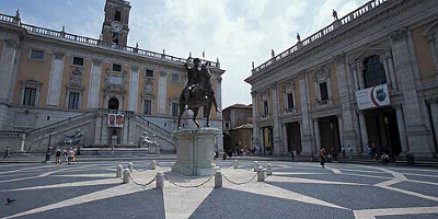
On the right is the Palazzo dei Conservatori or Palace of the Conservators.
This building was designed by Michelangelo over the remains Temple of Jupiter.
It is the entrance way to the Capitoline Museums, one of the first public museums in the world.
Its works are primarily Roman statues and its rooms extend underneath the the piazza, the Palazzo Nuovo on the left and also the tabularium beneath the Palazzo Senatorio with splendid views of the Roman Forum.
Famous works inside include the giant statue of Constantine from the Basilica of Constantine in the Roman Forum, the bronze she wolf which is the symbol of the city of Rome as well as remains of the Temple of Jupiter.
On the left is the Palazzo Nuovo, or New Palace, which was actually done in the 1600s as an exact copy of Michelangelo’s building to give the square symmetry.
It is connected to the Palazzo dei Conservatori by an underground tunnel and is part of the Capitoline Museums.
It’s more notable works include the colossal statue of Mars – the Roman God of War, the Dying Gaul, the Capitoline Venus, as well as busts of Roman Emperors and Greek philosophers.
capitoline museum rome
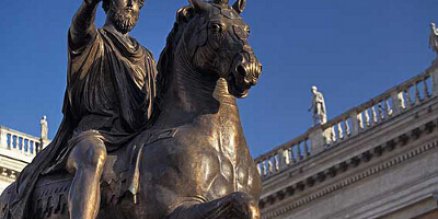 Statue of Marcus Aurelius
Statue of Marcus AureliusIn the middle of the square there is a copy of a bronze statue of Marcus Aurelius.
He was Roman Emperor from the 160s to 180s and was the last of the ‘five good Emperors’, according to Edward Gibbon, who ruled during the 2nd century AD.
He was depicted in Gladiator by Richard Harris, if you have seen that movie.
His son Commodus took over after his death and his reign is generally thought of as the start of the decline of the Roman Empire.
Aurelius was a good Emperor and spent most of his time battling the Germans or writing philosophy.
A stoic, his Meditations are still read to today by Philosophy students and normal people.
The statue is not the original, that is actually inside in the Museum on the right as it is 1800 years old.
The original, which is almost identical, was found on the Lateran Hill.
Pope Paul III asked Michelangelo which Emperor it was and he answered ‘Constantine’.
Michelangelo knew well that the Pope might destroy a pagan Emperor’s statue, but not one of Constantine, Rome’s first Christian Emperor.
He didn’t actually like the statue, he just thought it should not be destroyed.
The Pope asked him to make a pedestal for it which he did, here.
Thankfully Michelangelo wrote everything he did down in a diary, so we know more about his thoughts and movements than any other artist from the time.
The Campidoglio square is trapezoid shaped and was designed as such by Michelangelo due to the space available.
Among Michelangelo’s sketches was the floor design with a star in an oval.
He did not get around to it in his life time so Mussolini had it finished in 1940, four hundred years later.
Mussolini was very interested in Italy’s past although in some cases he would knock down some ancient structures for his own projects.
capitoline wolf
The Campidoglio is one of the most architecturally beautiful squares of Rome. It affords the visitor a chance to see works of the Roman Empire, Michelangelo and paintings by renaissance masters in an adjoining church. You can also get a fantastic view of the Roman Forum as the sun sets over it.
If you would like to take a tour of the squares of Rome including the Campidoglio by foot or by driving you can send me an email through the link in the menu.
3 hour Walking Tour of the Piazzas and Fountains of Rome Italy
Rated 5.0/5 based on a selection 10 customer reviews out of thousands.
